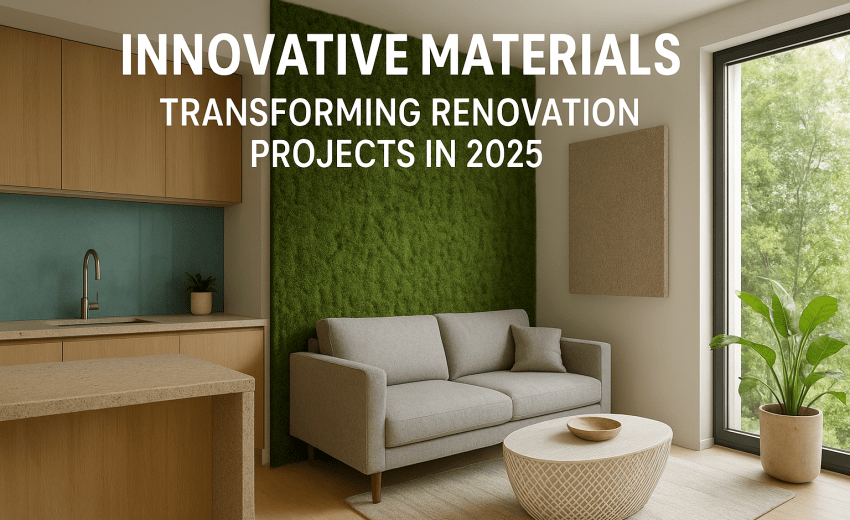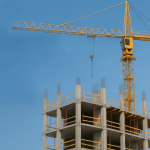
Sustainability at the Core
One of the most significant shifts in 2025 is the move toward environmentally responsible solutions. Renovation companies are integrating Innovative Materials that lower carbon footprints and extend product life cycles.
- Recycled composites: These provide strength and resilience while reducing waste. Flooring, countertops, and wall panels made from recycled plastics and metals are gaining popularity.
- Bio-based materials: Bamboo, hempcrete, and mycelium-based products are not only renewable but also lightweight and energy-efficient.
Sustainability is no longer optional; it’s a key factor driving renovation decisions across both residential and commercial projects.
Smart and Responsive Surfaces
In 2025, Innovative Materials go beyond static structures—they interact with their environment. Smart surfaces are being introduced into kitchens, bathrooms, and offices, offering convenience and adaptability.
- Self-healing coatings: These materials automatically repair minor scratches, keeping walls, furniture, and flooring looking new for longer.
- Temperature-responsive glass: Windows that adjust tint according to heat and light levels, reducing the need for air conditioning and artificial lighting.
These advancements not only improve user experience but also reduce maintenance costs over time.
Energy-Efficient Renovation Materials
Energy efficiency is a top priority in renovation projects. Innovative Materials are being designed to optimize energy consumption while maintaining comfort and style.
- Phase-change materials (PCMs): Used in insulation, they absorb and release heat, keeping indoor spaces naturally balanced.
- Solar-integrated panels: Roof tiles and façade systems now generate clean energy while blending seamlessly with architectural design.
The focus is on creating self-sufficient, energy-smart buildings that align with global sustainability goals.
Durability Meets Design
Renovation projects in 2025 no longer force a choice between durability and design. Innovative Materials are engineered to offer both.
- Ultra-high-performance concrete (UHPC): This provides exceptional strength and flexibility, making it ideal for structural and decorative applications.
- Lightweight composites: Stronger than steel yet easy to work with, these materials allow architects and designers to push creative boundaries.
This fusion of resilience and beauty ensures that renovated spaces remain visually appealing while withstanding everyday wear and tear.
Indoor Wellness and Comfort
Wellness-focused renovation is gaining traction, and Innovative Materials play a central role in creating healthier indoor environments.
- Low-VOC paints and finishes: These improve air quality and reduce health risks associated with toxic emissions.
- Acoustic panels made from recycled fibers: Designed to absorb noise, they enhance comfort in homes, offices, and commercial spaces.
By prioritizing wellness, renovations are transforming from purely aesthetic upgrades into holistic lifestyle improvements.
Digital Fabrication and Customization
With advancements in 3D printing and digital design, Innovative Materials can now be customized with unmatched precision. Builders and designers are using these technologies to create unique finishes, tailored structures, and one-of-a-kind furniture pieces.
- 3D-printed tiles and fixtures: Allow endless design options at lower costs.
- Custom-fit structural components: Reduce waste and improve efficiency on construction sites.
This shift toward personalized renovation ensures that projects are not only modern but also meaningful to the end user.
The Future Outlook
As we look beyond 2025, Innovative Materials will continue driving the renovation industry toward smarter, greener, and more efficient solutions. The convergence of technology, sustainability, and creativity is setting the stage for a new era in design and construction.
Renovation projects are no longer about replacing old with new—they’re about reimagining how spaces can adapt to the evolving needs of society. Whether it’s reducing energy costs, enhancing comfort, or pushing the limits of design, Innovative Materials are at the heart of this transformation.
Conclusion
Innovative Materials are not just tools of construction; they are catalysts of change in the renovation industry. By embracing eco-friendly composites, smart surfaces, energy-efficient systems, and health-conscious finishes, today’s projects are becoming future-proof investments. Renovation in 2025 is a dynamic process fueled by innovation, and businesses that adopt these advancements will stay ahead in a competitive market.
The future of renovation is here—and it’s built with Innovative Materials.
Ready to Build with Confidence?
Get in touch with Charminar to learn how our project management expertise can streamline your next development.
📧 contact@bluediamondfm.com
📞 +971 56 705 4223
🌐 https://charminardubai.com/
Frequently Asked Questions (FAQ)
What are Innovative Materials in renovation?
Innovative Materials are advanced construction and design products that combine sustainability, durability, and technology. Examples include recycled composites, smart glass, bio-based alternatives, and self-healing coatings.
Why are Innovative Materials important in 2025 renovations?
They enhance energy efficiency, reduce environmental impact, improve indoor wellness, and provide long-lasting durability, making them essential for modern renovation projects.
Are Innovative Materials more expensive than traditional ones?
While some may have higher upfront costs, they often save money in the long run by lowering maintenance, improving energy efficiency, and extending the lifespan of structures.
Can Innovative Materials be used in both residential and commercial projects?
Yes. They are versatile and can be applied in homes, offices, retail spaces, and large-scale commercial developments.
How do Innovative Materials support sustainability goals?
They reduce waste, lower carbon emissions, and often incorporate renewable or recycled content, making them a key factor in green building certifications and eco-friendly renovation.






